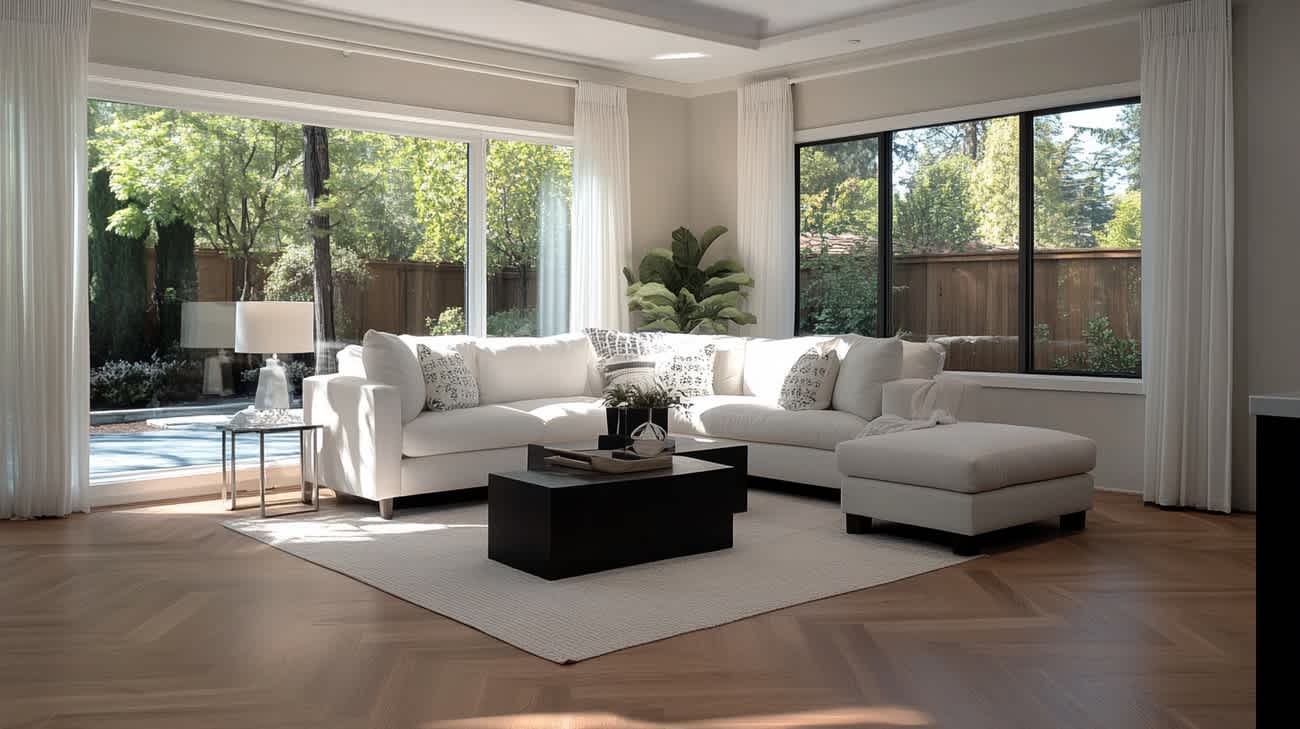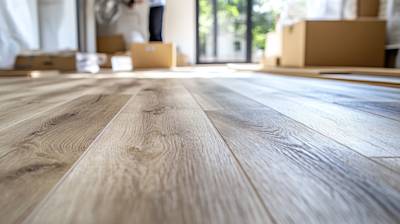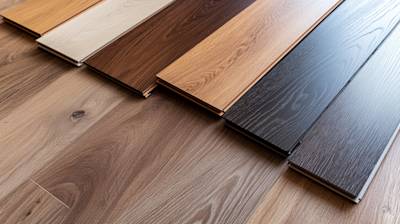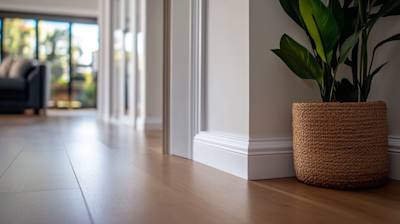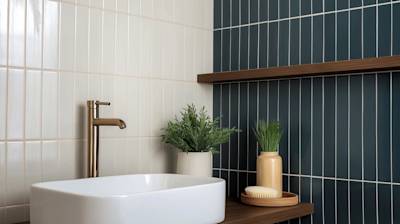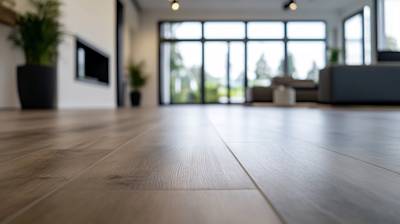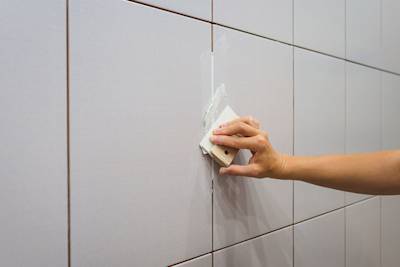When it comes to flooring options, few can compare to the timeless sophistication of parquet flooring. This classic style, popular for its intricate design and rich look, has been gracing homes and establishments worldwide for centuries. If you're considering this option, this article will provide endless insight on everything parquet.
What Is Parquet Flooring?
Parquet flooring originates from France and dates back to the 16th century. The term Parquet derives from the French word 'parqueterie', translating to 'small compartment'. It comprises pieces of wood arranged in an array of geometric patterns—most commonly, the herringbone and block design—to offer an eye-catching flooring solution.
Types of Parquet Flooring
Parquet flooring may be constructed from various materials, each carrying distinct qualities:
- Hardwood: Crafted from species like oak, walnut, cherry, or maple, hardwood parquet offers a durable, long-lasting solution.
- Laminate: A cost-friendly wooden alternative, laminate parquet flooring stands up to wear and tear and is easy to install.
- Engineered Wood: Engineered parquet comes from multiple layers of wood and provides a mix of durability and aesthetic appeal.
Construction and Installation of Parquet Flooring
Parquet flooring's construction and installation depend on the chosen material. Typically, it involves cutting, arranging, and fitting small wooden pieces into a desired pattern, and then securing them to a subfloor.
The Artistry of Making Parquet Floors
Crafting parquet flooring involves various steps. The process usually starts with the wood being cut into small strips or blocks, which, through careful design and crafting, create intricate geometric patterns. This meticulous task requires a keen eye and Tedious attention to detail, to ensure a seamless result.
Installation of Parquet Flooring
The installation may involve either nailing, gluing, or clicking the pieces, depending on the construction method. A professional installer will ensure that the pieces fit together perfectly - for both visual appeal and durability.
Maintenance and Care of Parquet Flooring
Proper care and maintenance not only retain parquet flooring's aesthetic appeal but significantly contribute to its lifespan. Here’re steps to consider:
- Regular Dusting and Sweeping: Sweeping or vacuuming removes dirt that could scratch the finish of the parquet flooring.
- Proper Cleaning: Although water is acceptable for cleaning, ensure that the mop is well wrung out to avoid water damage.
- Buffing and Polishing: Depending on foot traffic, regular buffing and polishing are essential to maintain the shine.
- Repair: Repair minor scratches or damages as soon as you spot them to prevent further deterioration.
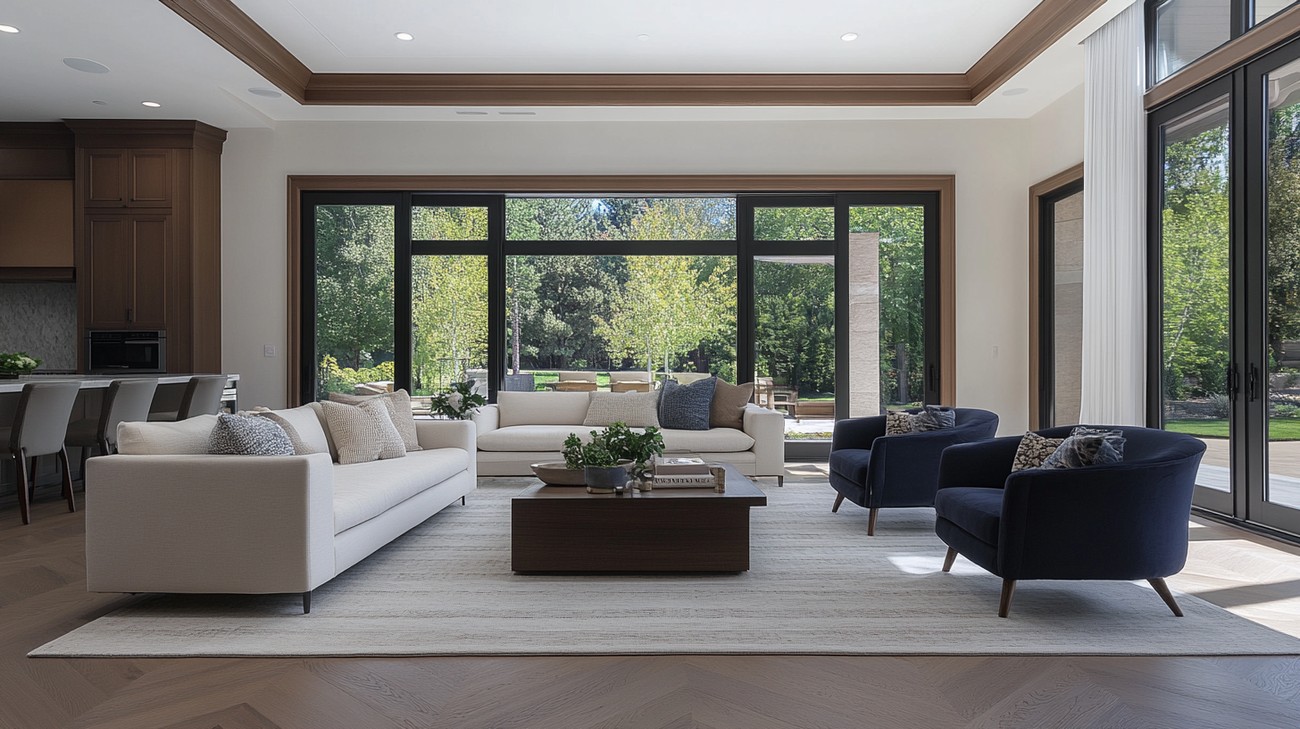
Frequently Asked Questions about Parquet Flooring
What is the History of Parquet Flooring?
Parquet flooring has a rich history dating back to the 16th century in France. It was introduced as a stylish alternative to marble flooring in French homes and slowly gained popularity all over Europe. Castles and mansions often featured parquet patterns, which were considered a symbol of opulence and elegance.
How Durable is Parquet Flooring?
Parquet flooring is highly durable and can last for several decades if properly maintained. This longevity is due to the high-quality wood that is used in the construction. Like other types of hardwood floors, parquet floors can be refinished to restore their original luster and remove signs of wear.
What Types of Wood are Used in Parquet Flooring?
Typically, parquet flooring is made from a variety of hardwood species. The most common types include oak, walnut, cherry, and maple. Each wood type offers different colors, patterns, and grains, adding aesthetic variety to your parquet flooring options.
Can Parquet Flooring Be Installed Over an Existing Floor?
Yes, parquet flooring can be installed over an existing floor, provided that the old surface is completely flat, stable, free of moisture and completely clean. It is possible to install parquet flooring over concrete, but a moisture-proof barrier is needed.
What Makes Parquet Flooring Unique?
What sets parquet flooring apart is the intricate geometric patterns that can be created. Patterns can range from simple to sophisticated, and this provides a unique aesthetic appeal that is not possible with traditional, straight-laid hardwood flooring.
How Do You Maintain Parquet Flooring?
Maintenance for parquet flooring includes regular sweeping or vacuuming to remove dirt and grit which can scratch the surface. Additionally, spills should be wiped up immediately to prevent water damage. Using a wood floor cleaner will keep the parquet shining and looking new.
Is Parquet Flooring Suitable for Bathrooms and Kitchens?
While parquet flooring is versatile and aesthetically pleasing, it is not recommended for high-moisture areas such as bathrooms and kitchens. Just like any other wood flooring, if subjected to excess moisture, it can warp, buckle or crack.
Are there different styles of Parquet Flooring?
Yes, some popular parquet flooring patterns include the Herringbone, Basket, Chevron, and Versailles styles. Each pattern has a unique look and varying levels of intricacy. Depending on the interior decor of the home, you can choose a pattern that complements it perfectly.
Can Parquet Flooring be Refinished?
Absolutely. One of the benefits of choosing parquet flooring is that it can be refinished. If it starts to look a bit worn, you can bring it back to life by sanding and resealing it, effectively removing scratches and discoloration that may have occurred over time. However, it should be noted that this process can only be carried out a finite number of times, depending on the thickness of the wood.

Pros of Parquet Flooring
Aesthetically Pleasing
Immediate Appeal
One of the biggest advantages of Parquet flooring is its aesthetic appeal. Because it's made of tiny, cut pieces of wood arranged in either simple or complex geometric patterns, Parquet flooring can create a stunning visual impact that instantly enhances the appeal and elegance of any room. The combination of different wood grains and colors makes for a rich, multidimensional effect that’s hard to beat.
Unique Design
Since parquet flooring is available in a wide variety of patterns, every installation can potentially be unique, adding to the allure of this flooring option. Traditional formats like Herringbone or Chevron give a classic and timeless look, while more complex designs like basket-weave or Versailles can lend the space an incredibly opulent feel. This versatility allows homeowners to use parquet flooring to express their personal style and tastes.
High Quality and Durability
Robust Construction
Parquet flooring’s traditional construction with multiple layers of wood makes it extremely robust and long-lasting. It is hard-wearing and can withstand the regular wear and tear associated with high foot traffic areas in the home very well.
Resilience to Temperature Changes
Since parquet is made from solid wood, it doesn't expand or contract as much as other types of flooring during temperature fluctuations, reducing the risk of damage from environmental changes.
Potential for Refinishing
Parquet floors can be sanded down and refinished many times during their lifespan. This ability to renew the surface makes them a long-term flooring option that can last for generations, potentially making them more cost-effective in the long run.
Cons of Parquet Flooring
Cost
Initial Investment
One significant disadvantage of parquet flooring is its high initial cost. The complexity of the designs and the high level of skill required for installation make parquet one of the more expensive flooring options on the market.
Maintenance Cost
While parquet flooring can last a long time, maintaining its beauty can also be a tad expensive. It may require professional cleaning and periodic refinishing, particularly if the flooring gets scratched or stained.
Installation Difficulties
The installation of parquet flooring is not simple and often requires a professional installer to ensure that the pattern is aligned correctly. Mistakes during installation can lead to noticeable imperfections in the pattern and could potentially affect the overall look and quality of the floor.
Susceptibility to Moisture
Water Damage
Due to its wood composition, parquet flooring can be vulnerable to moisture damage. Prolonged exposure to water can cause the wood to warp or discolor. Therefore, parquet flooring might not be suitable for areas like bathrooms or kitchens where spills and moisture are frequent.
Humidity Concerns
Similarly, changes in humidity can affect parquet floors. Too much humidity can cause the wood to swell, while too little can cause it to shrink, creating gaps. These effects can be mitigated to some extent with proper sealing and regular maintenance, but it’s something homeowners should be aware of nonetheless.
Sensitive to Scratches
While parquet flooring is indeed durable, it's not immune to damage. It can be susceptible to scratches, particularly from pets with sharp claws or from moving heavy furniture. These scratches can be sanded out and the floor refinished, but this can add to the maintenance costs.

Misconception 1: Parquet Flooring is outdated and old fashioned
It's quite common for homeowners to regard parquet flooring as old-fashioned, outdated, or out of style. This perception likely stems from the flooring's peak popularity in the mid-twentieth century, when it was commonly seen in homes and buildings of that era. However, it's important to note that while parquet flooring does have a long history, this doesn't mean that it's trapped in the past.
Timelessness is not outdatedness
The timeless patterned aesthetics of parquet flooring has been reused in different eras and is still admired today. It offers a unique, intricate geometric design that can't be easily replicated by other types of flooring, bringing a distinctive character and warmth to any space. In fact, a well-installed and maintained parquet floor can last for decades, serving as a testament to its timeless appeal.
Trend resurgence
Today, with a shift towards more sustainable and reclaimed materials, parquet flooring has seen a resurgence in popularity. Designers and homeowners alike appreciate its natural beauty, craftsmanship, and the character it brings to a space.
Misconception 2: Parquet flooring requires extensive maintenance
Another widespread misinformation about parquet flooring is the idea that it requires extensive maintenance. While it's true that parquet flooring needs care to keep it in its best condition, it's not as demanding as some might think.
Regular cleaning
Like any other type of flooring, parquet does require regular cleaning. But this is not different from other hardwood flooring types – sweeping or vacuuming to remove dirt and dust and occasional damp mopping is usually all it takes to keep it clean.
Sealing and refinishing
Over time, you may need to seal and refinish your parquet floor to restore its original lustre. However, this isn't a frequent requirement – often only needed every few decades, depending on the floor's level of wear and tear.
Misconception 3: Parquet flooring is only suited for grand and luxury homes
The complex patterns of parquet flooring might give the impression that it only belongs in grand or luxury homes. However, this is a hiccup in understanding its versatility.
Versatility of parquet flooring
Parquet flooring is highly versatile. It can look just as good in a modern, minimalist apartment as it would in a large, traditional mansion. In modern interior design, it's quite popular for adding character and visual interest to otherwise simple spaces.
Size and design variety
Furthermore, parquet flooring comes in a range of designs, sizes and finishes, which means it can be tailored to suit almost any style or budget.
Misconception 4: All parquet flooring is eco-unfriendly
With increased emphasis on environmental sustainability, many homeowners are weary of parquet flooring due to claims that it's not eco-friendly. However, this is only partially true.
Sourcing of wood
Parquet floors are made of wood, which raises concerns about deforestation and the environment. However, many manufacturers now source their wood responsibly from sustainable sources. Check for certifications from organizations like the Forest Stewardship Council (FSC) that certify the wood has been responsibly sourced.
Longevity
It's also essential to consider the longevity of parquet floors. Unlike some other types of flooring that may need to be replaced every 10 or 15 years, a well-maintained parquet floor can last for decades, leading to less waste in the long run.
In conclusion, don't get caught up in the misinformation about parquet flooring. When sourced responsibly and maintained properly, it can be a beautiful, and environmentally conscious choice for any home.
Summary
Looking at it overall, parquet flooring is an exceptional choice for anyone wishing to add a touch of elegance and warmth to their home. Its intricate patterns and designs not only make a statement but also offer durable and hard-wearing surface for years to come. So, whether you're renovating an old property or striking out on a fresh building project, parquet flooring is definitely worth considering.
Parquet flooring isn't just about beauty though. It’s also a practical choice for homes and even offices. The durability and easy maintenance of parquet flooring make it a popular choice for those in search of timeless style with minimal upkeep. Its versatility in design, style, and finish also means that regardless of your design aesthetics, this beautiful and unique flooring style could be the perfect fit for your space.
Parquet flooring may carry a more considerable initial cost compared to other types of flooring. However, it's worth remembering the long-term benefits this flooring option offers. It stands the test of time and elevates your house's visual appeal like no other type. If you're searching for a flooring solution that combines charm, elegance, and durability, then parquet flooring might just be what you're after.
About Solid Construction & Design
Solid Construction & Design, based in the dazzling Sacramento, CA, is not just about bricks and beams but about realizing visions and fulfilling dreams. We combine robust technical expertise, a deep dedication to quality, and a passion for customer satisfaction to deliver stellar construction and design solutions. We are a full-service remodeling, renovation, and building company, taking pride in eliminating the stress of construction projects and making it an enjoyable process for every client. With a rich reputation for reliability and creativity, we are paving the way for impressive residences and commercial spaces that truly reflect the spirit of Sacramento.

